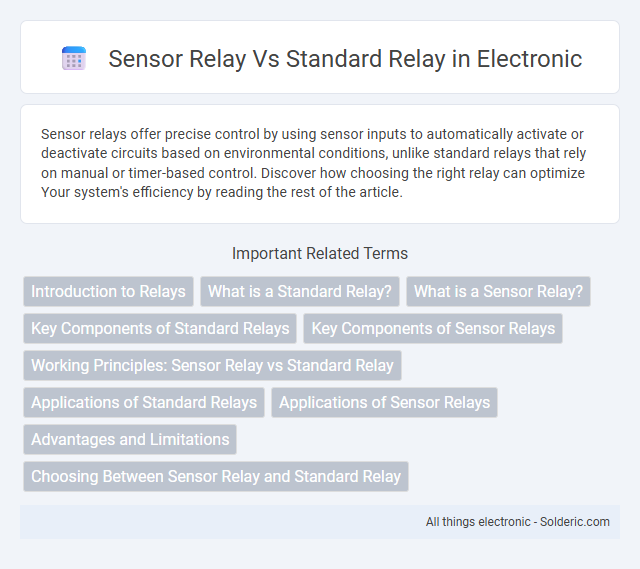Sensor relays offer precise control by using sensor inputs to automatically activate or deactivate circuits based on environmental conditions, unlike standard relays that rely on manual or timer-based control. Discover how choosing the right relay can optimize Your system's efficiency by reading the rest of the article.
Comparison Table
| Feature | Sensor Relay | Standard Relay |
|---|---|---|
| Function | Integrates sensor input to control switching | Simple electrical switching device |
| Input Type | Sensor signals (analog/digital) | Manual or basic electronic trigger |
| Output Control | Automated based on sensor data | Manual or timer-based switching |
| Applications | Automation, IoT devices, safety systems | General electrical circuits, load switching |
| Complexity | Higher due to sensor interfacing | Low, simple design |
| Cost | Higher, due to integrated components | Lower, basic components |
| Response Time | Fast, depends on sensor speed | Standard, mechanical switching delay |
Introduction to Relays
Relays are electrically operated switches used to control circuits by opening and closing contacts in another circuit. Sensor relays integrate sensing elements to react automatically to specific physical conditions, enhancing automation and precision. Standard relays rely on manual or external electronic control signals, making them versatile for general switching applications without built-in sensing capabilities.
What is a Standard Relay?
A standard relay is an electromechanical switch used to control a high-power circuit with a low-power signal, typically consisting of an electromagnetic coil and one or more sets of contacts. It operates by energizing the coil, which creates a magnetic field that moves the contacts to open or close the circuit. Standard relays are widely used in automotive, industrial, and household applications for functions like switching motors, lights, and other electrical loads.
What is a Sensor Relay?
A sensor relay is an advanced switching device that integrates sensor inputs to control electrical circuits automatically based on environmental changes or specific conditions. Unlike standard relays, which manually or remotely switch circuits on and off, sensor relays activate in response to real-time data such as temperature, light, or motion. These relays enhance automation efficiency, reduce energy consumption, and improve system responsiveness in industrial and smart home applications.
Key Components of Standard Relays
Standard relays consist of essential key components including an electromagnet coil, an armature, a spring, and a set of electrical contacts. The electromagnet coil generates a magnetic field when energized, causing the armature to move and either open or close the contacts. These mechanical parts work together to control high-power circuits by using a low-power signal, distinguishing standard relays from sensor relays that integrate sensing elements for automated control.
Key Components of Sensor Relays
Sensor relays incorporate key components such as sensing elements, amplifiers, and switching mechanisms that detect and respond to physical changes like temperature, pressure, or light, unlike standard relays which primarily rely on electromagnetic coils. These components allow sensor relays to provide precise control and automation by converting physical signals into electrical switching operations. Understanding the specific sensor type and its corresponding amplifier is essential for optimizing Your system's responsiveness and accuracy.
Working Principles: Sensor Relay vs Standard Relay
Sensor relays operate by detecting specific environmental inputs such as temperature, light, or motion and then activating the circuit based on these sensor signals. Standard relays function using an electromagnetic coil that, when energized, mechanically closes or opens contacts to control the electrical flow. Your choice between a sensor relay and a standard relay depends on whether automated response to sensor inputs or simple electrical switching is required.
Applications of Standard Relays
Standard relays are widely used in applications such as automotive systems, home automation, industrial machinery, and HVAC controls where simple on/off switching is required. These relays handle high current loads and isolate control circuits from high voltage, protecting sensitive electronic components. Your systems benefit from standard relays' reliability in switching motors, lights, and other heavy electrical loads.
Applications of Sensor Relays
Sensor relays are essential in automation systems, enabling precise control of sensor inputs for industrial machinery, HVAC systems, and safety monitoring. Your control system benefits from sensor relays by detecting specific conditions like motion, temperature, or light and triggering appropriate responses instantly. Unlike standard relays, sensor relays offer enhanced sensitivity and customizable switching thresholds for accurate real-time application performance.
Advantages and Limitations
Sensor relays offer precise control and enhanced responsiveness by directly detecting changes in environmental or system parameters, reducing the need for manual monitoring. Standard relays provide reliable switching capabilities with simpler design and lower cost but lack the adaptive functionality found in sensor relays. Your choice depends on whether you prioritize automation and accuracy over simplicity and budget constraints.
Choosing Between Sensor Relay and Standard Relay
Choosing between a sensor relay and a standard relay depends on the application requirements for automation and sensitivity. Sensor relays integrate detection and switching functions, ideal for precise control in security, lighting, and industrial systems, while standard relays provide straightforward on/off control suitable for general electrical load switching. Factors such as response time, load type, and environmental conditions influence the optimal relay choice for reliable and efficient system performance.
Sensor Relay vs Standard Relay Infographic

 solderic.com
solderic.com